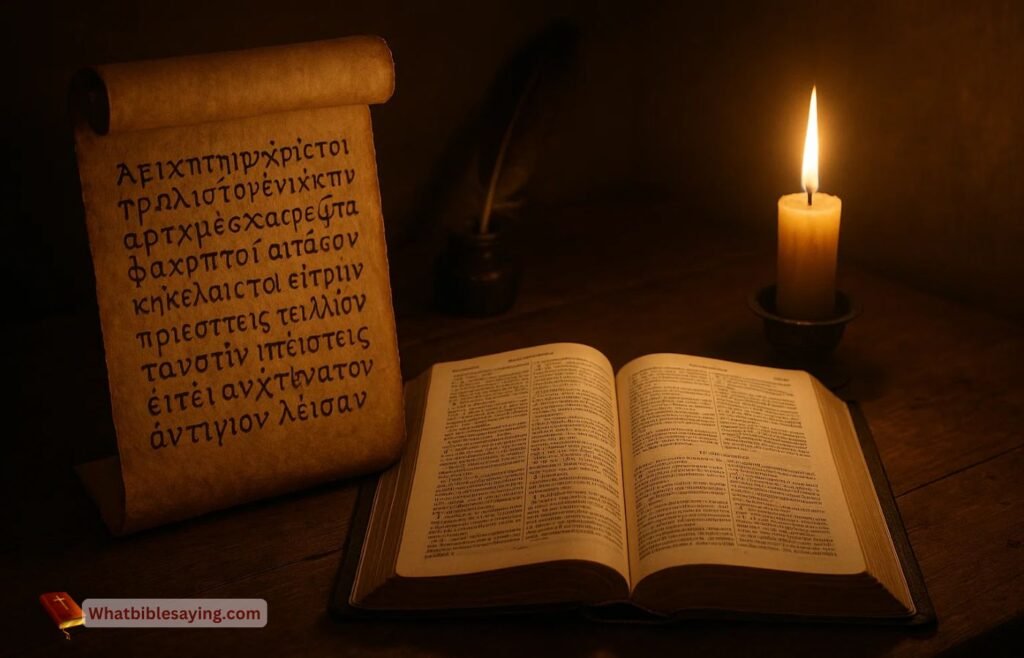 If you’ve ever flipped through the New Testament and wondered why so many books are short, letter-like, and addressed to people or churches you’re not alone. Those are epistles, and they carry some of the most personal, powerful teachings in the entire Bible. But which books of the Bible are epistles? And why do they matter so much?
If you’ve ever flipped through the New Testament and wondered why so many books are short, letter-like, and addressed to people or churches you’re not alone. Those are epistles, and they carry some of the most personal, powerful teachings in the entire Bible. But which books of the Bible are epistles? And why do they matter so much?
Let’s explore the meaning behind these sacred letters, the people who wrote them, and how they still speak to us today.
What Does “Epistle” Mean in the Bible?
The word epistle simply means “letter.” In the context of the Bible, epistles are written messages from apostles or early church leaders to churches, groups of believers, or individuals.
Imagine opening an old, hand-written letter filled with care, wisdom, and raw honesty—that’s what these epistles were for early Christians. These were the writings that helped early Christians figure out how to live out their faith in a messy, often hostile world.
You’ll find most of these letters tucked into the New Testament, not arranged by when they were written, but often by who wrote them or how long they are.
How Many Epistles Are in the Bible?
There are 21 epistles in the Bible, all in the New Testament. These letters follow the four Gospels (Matthew, Mark, Luke, John) and the Book of Acts.
Here’s how they break down:
13 are written by the Apostle Paul (known as the Pauline Epistles)
8 are written by other apostles or church leaders (called the General or Catholic Epistles)
What Are the 13 Epistles of Paul?
You could say Paul’s letters are the heart and soul of early Christian teaching full of deep truths and practical advice. His letters are deeply theological, yet pastoral. They were written to specific churches and individuals dealing with real problems, questions, and spiritual needs.
Here’s a list of the 13 epistles of Paul in the order they appear in the Bible:
| Epistle | Recipient(s) | Type |
|---|---|---|
| Romans | Believers in Rome | Church letter |
| 1 Corinthians | Church in Corinth | Church letter |
| 2 Corinthians | Church in Corinth | Church letter |
| Galatians | Churches in Galatia | Church letter |
| Ephesians | Church in Ephesus | Church letter |
| Philippians | Church in Philippi | Church letter |
| Colossians | Church in Colossae | Church letter |
| 1 Thessalonians | Church in Thessalonica | Church letter |
| 2 Thessalonians | Church in Thessalonica | Church letter |
| 1 Timothy | Timothy (a young pastor) | Personal letter |
| 2 Timothy | Timothy | Personal letter |
| Titus | Titus (church leader in Crete) | Personal letter |
| Philemon | Philemon (Christian slave owner) | Personal letter |
These epistles are deeply personal at times Paul writes from prison, shares his heartaches, and even pleads for forgiveness for a runaway slave (Philemon).
What Are the 21 Epistles Books in the Bible?
Now let’s look at the complete list of the 21 epistles in the Bible, including both Pauline and General Epistles:
The Pauline Epistles (13 Books)
Romans
1 Corinthians
2 Corinthians
Galatians
Ephesians
Philippians
Colossians
1 Thessalonians
2 Thessalonians
1 Timothy
2 Timothy
Titus
Philemon
The General Epistles (8 Books)
These are written by apostles like Peter, James, John, and others. They’re called “general” because they’re usually written to wider audiences, not just one church.
Hebrews (author unknown possibly Paul, Barnabas, or Apollos)
James (by James, the brother of Jesus)
1 Peter
2 Peter
1 John
2 John
3 John
Jude
Each of these brings something unique. James hits hard on living out your faith. Peter writes to suffering believers. John speaks of love and truth. Jude warns of false teachers.
Why Are the Epistles So Important?
These letters shaped the earliest followers of Jesus and they still shape us.
Here’s why they matter:
Doctrine and Teaching: Romans, for example, gives us a deep dive into salvation, sin, grace, and righteousness.
Church Leadership: Timothy and Titus help leaders know how to shepherd God’s people.
Christian Living: Books like James and Philippians teach practical ways to live out your faith daily.
Encouragement and Correction: Many epistles address problems division, immorality, heresies and call believers back to truth.
They also show us the real-life struggles of Christians in the first century: persecution, doubt, false teachers, and relational tensions. Sound familiar?
The Structure of a Biblical Epistle
Most epistles follow a pretty standard structure much like a formal letter:
Greeting – The writer introduces themselves and addresses the recipient(s).
Thanksgiving or Prayer – A short section of gratitude or a blessing.
Body – This is the meat teaching, correction, encouragement, or doctrine.
Conclusion – Often includes personal notes, travel plans, greetings, or final instructions.
Take Philippians, for example. Paul begins by thanking God for the church’s support, shares his joy and chains from prison, and ends with a warm farewell.
Are the Epistles Still Relevant Today?
Absolutely.
You don’t have to be a Bible scholar to find wisdom in the epistles. Whether you’re dealing with anxiety (Philippians 4:6), struggling to forgive (Philemon), leading others (1 Timothy), or trying to live out your faith (James), these letters still speak into our hearts today.
Many Christians find their favorite verses, spiritual breakthroughs, or even callings through reading the epistles.
A Quick Summary Table
Here’s a quick glance to help you remember which books of the Bible are epistles:
| Category | Books | Total |
|---|---|---|
| Pauline Epistles | Romans → Philemon | 13 |
| General Epistles | Hebrews → Jude | 8 |
| Total Epistles | 21 books | 21 |
These books are all part of the New Testament, beginning right after the Acts of the Apostles and before the Book of Revelation.
Fun Facts About the Epistles
Shortest Epistle? 3 John (only 219 words in Greek!)
Longest Epistle? Romans (over 7,000 words)
Most Quoted? Romans, Galatians, and 1 Corinthians are commonly quoted in sermons.
Mysterious Author? Hebrews doesn’t name its writer, which has sparked debate for centuries.
Personal Reflection: What the Epistles Mean to Me
When I first read the epistles, I thought they were old, dusty letters with little relevance to my life. But I was wrong.
Paul’s raw honesty in 2 Corinthians made me feel less alone in my weakness. James challenged me to stop just talking about faith and actually live it out. Philippians reminded me that even in hard times, there’s joy.
These letters are deeply human. They’re not just theology they’re stories, prayers, instructions, and sometimes rebukes written by people who loved Jesus and the church. And they still breathe life today.
Conclusion: Why Knowing the Epistles Matters
So, which books of the Bible are epistles? They’re the 21 powerful letters nestled in the New Testament from Romans to Jude. These aren’t just theological essays. They’re the personal writings of real people, facing real problems, pointing others back to the hope found in Jesus.
Whether you’re new to the Bible or have read it for years, diving into the epistles is like sitting across from early apostles and hearing them say: Stay strong. Keep the faith. Love one another. And don’t give up.











